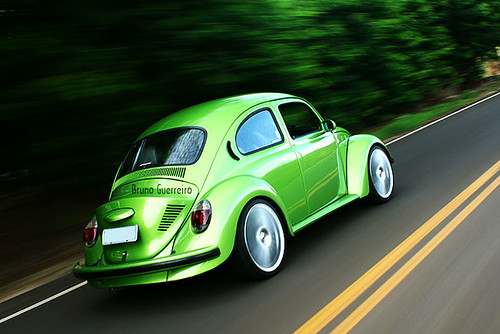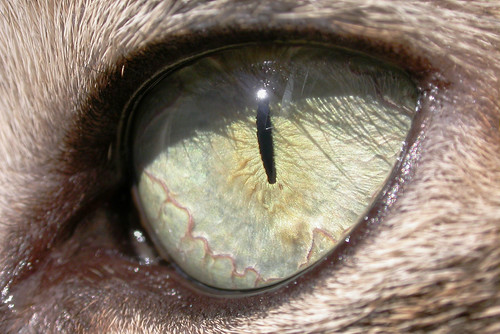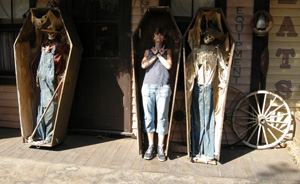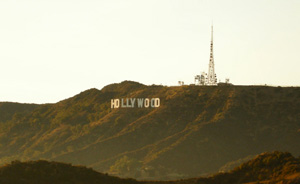 A movement which scans a scene horizontally, the effect is enhanced by using other techniques as well such as rails to move the whole camera platform, and can be used as a dramatic implement. They are particularly useful in capturing any fast moving subject such as a car or a cyclist. It is often used when following an object that needs to be kept in the middle of the frame, the length of the exposure must be long enough to allow the background to blur due to the movement of the camera. This type of shot has two main functions: To direct the attention from one place to another and to follow movement and action. Eg,the picture above. In a film the car would be moving at a normal speed however it would still need to be in the centre of the frame and because of the camera moving alongside the car it has caused the scenery to blur making it an eye catching image.
A movement which scans a scene horizontally, the effect is enhanced by using other techniques as well such as rails to move the whole camera platform, and can be used as a dramatic implement. They are particularly useful in capturing any fast moving subject such as a car or a cyclist. It is often used when following an object that needs to be kept in the middle of the frame, the length of the exposure must be long enough to allow the background to blur due to the movement of the camera. This type of shot has two main functions: To direct the attention from one place to another and to follow movement and action. Eg,the picture above. In a film the car would be moving at a normal speed however it would still need to be in the centre of the frame and because of the camera moving alongside the car it has caused the scenery to blur making it an eye catching image.
Sunday, 18 September 2011
Camera angles- Pan shot
 A movement which scans a scene horizontally, the effect is enhanced by using other techniques as well such as rails to move the whole camera platform, and can be used as a dramatic implement. They are particularly useful in capturing any fast moving subject such as a car or a cyclist. It is often used when following an object that needs to be kept in the middle of the frame, the length of the exposure must be long enough to allow the background to blur due to the movement of the camera. This type of shot has two main functions: To direct the attention from one place to another and to follow movement and action. Eg,the picture above. In a film the car would be moving at a normal speed however it would still need to be in the centre of the frame and because of the camera moving alongside the car it has caused the scenery to blur making it an eye catching image.
A movement which scans a scene horizontally, the effect is enhanced by using other techniques as well such as rails to move the whole camera platform, and can be used as a dramatic implement. They are particularly useful in capturing any fast moving subject such as a car or a cyclist. It is often used when following an object that needs to be kept in the middle of the frame, the length of the exposure must be long enough to allow the background to blur due to the movement of the camera. This type of shot has two main functions: To direct the attention from one place to another and to follow movement and action. Eg,the picture above. In a film the car would be moving at a normal speed however it would still need to be in the centre of the frame and because of the camera moving alongside the car it has caused the scenery to blur making it an eye catching image.
Saturday, 17 September 2011
Camers angles- Oblique/Canted Angle
 Also known as the 'Dutch', 'German', and 'Batman' angle. Often used to suggest transition, instability and disorientation, it is achieved by tilting the camera off to the side so that the shot is composed with the horizon at an angle to the bottom of the frame. This angle is very popular in horror movies and when the camera becomes the 'eyes' of a character to show what they are seeing, this is a very effective technique to use in a film, however over using this angle can become a subject of mockery and critisium. The use of the cantated angle originated from Germany in the 1930s and quickly spread to other regions of the world, it was highly used in the tv series 'batman'.
Also known as the 'Dutch', 'German', and 'Batman' angle. Often used to suggest transition, instability and disorientation, it is achieved by tilting the camera off to the side so that the shot is composed with the horizon at an angle to the bottom of the frame. This angle is very popular in horror movies and when the camera becomes the 'eyes' of a character to show what they are seeing, this is a very effective technique to use in a film, however over using this angle can become a subject of mockery and critisium. The use of the cantated angle originated from Germany in the 1930s and quickly spread to other regions of the world, it was highly used in the tv series 'batman'.
Camera angles- Birds eye view
 This angle shows a scene from directly overhead, as though the observer were a bird giving it a 3D like quality.The angle is viewed at an approximately 45 degrees and puts the audience in a godlike position looking down on the action. It is mostly common for places such as towns, cities, homes and neighbourhood to be captured from this angle as it shows the scene from a different perspective and shows the image more clearly, which gives the audience a better understanding of the setting. It can be used to emphasis the compactness or insignificance of the subjects and to establish where the character is. Directors often use the birds eye view when they want to make some kind of dramtic comment on a sence or character.
This angle shows a scene from directly overhead, as though the observer were a bird giving it a 3D like quality.The angle is viewed at an approximately 45 degrees and puts the audience in a godlike position looking down on the action. It is mostly common for places such as towns, cities, homes and neighbourhood to be captured from this angle as it shows the scene from a different perspective and shows the image more clearly, which gives the audience a better understanding of the setting. It can be used to emphasis the compactness or insignificance of the subjects and to establish where the character is. Directors often use the birds eye view when they want to make some kind of dramtic comment on a sence or character.
Camera angles- Extreme close up
 Extreme close ups are artificial magnified shots, which fill up the screen and are way beyond what the human eye could experience in reality. As in the picture above, having an extreme close up of a face would express only the mouth or eyes, there is no background viable at all. This shot is often used for dramatic effect, however when using this type of angle the shot has to be taken cautiously as the slightest of shake or error can be noticeable.
Extreme close ups are artificial magnified shots, which fill up the screen and are way beyond what the human eye could experience in reality. As in the picture above, having an extreme close up of a face would express only the mouth or eyes, there is no background viable at all. This shot is often used for dramatic effect, however when using this type of angle the shot has to be taken cautiously as the slightest of shake or error can be noticeable.
Friday, 16 September 2011
Camera angles- Close up
 Using a close up shot in photography or film making tightly frames a person or an object,displaying the most detail and concentrating on usually just one subject ie, in the picture above, the shot has captured the baby's face and not the rest of his body,this is so they can detain and show the importance of all the fine features.In a close up a background isn't included as everything else is just a blur. In a film using a close up would enable the audience to go inside the mind of a character, as facial expressions and emotions would be shown more clearly, these shots are very intimate as in reality you wouldn't let strangers get that close to your face. Over using close ups can leave viewers being confused and uncertain as to what that are seeing.
Using a close up shot in photography or film making tightly frames a person or an object,displaying the most detail and concentrating on usually just one subject ie, in the picture above, the shot has captured the baby's face and not the rest of his body,this is so they can detain and show the importance of all the fine features.In a close up a background isn't included as everything else is just a blur. In a film using a close up would enable the audience to go inside the mind of a character, as facial expressions and emotions would be shown more clearly, these shots are very intimate as in reality you wouldn't let strangers get that close to your face. Over using close ups can leave viewers being confused and uncertain as to what that are seeing.
Camera angles- Long shot
 This is the most complicated shot to catergorize showing the entire human body, it is generally the one which shows the image as 'life size', ie, a figure of a man would appear 6ft tall and in a cinema it would be the real distance between the audience and the screen. Like this photo you can see that the heads are at the top of the screen and the feet are at the bottom, plenty of background still emerges even though the key focus is on the characters.
This is the most complicated shot to catergorize showing the entire human body, it is generally the one which shows the image as 'life size', ie, a figure of a man would appear 6ft tall and in a cinema it would be the real distance between the audience and the screen. Like this photo you can see that the heads are at the top of the screen and the feet are at the bottom, plenty of background still emerges even though the key focus is on the characters.
Camera angles- Extreme long shot
 Extreme long shots are also known as the wide shot or establishing shot, they can be taken from up to a quarter of a mile away and typically shows the entire object or human figure. It is often used to show a large amount of landscape thrilling action,such as in a war film or exhilarating movie.The shot gives a general impression rather than a precise finding so there wouldn't be much detail visible, these shots are pefect to empasis a background or an enviroment a character is against.
Extreme long shots are also known as the wide shot or establishing shot, they can be taken from up to a quarter of a mile away and typically shows the entire object or human figure. It is often used to show a large amount of landscape thrilling action,such as in a war film or exhilarating movie.The shot gives a general impression rather than a precise finding so there wouldn't be much detail visible, these shots are pefect to empasis a background or an enviroment a character is against.
Match on action:
This film editing technique is also called 'cutting on action', its purpose is to give the impression of continuous time when watching the edited film. This happens when one shot is cut to another, however still matching the first shots action. You would have a topic to begin the action which would be the first shot and the next shot would be to carry it through to completion.The audience are distracted from noticing the cut, due to a visual bridge. If the cuts do not match the effect will be noticeable and the action will loose its illusion. http://www.youtube.com/watch?v=lXqXExvwbQY (starts at 0.16)
In this clip it is really important for them to be getting the cuts accurate, otherwise the scene wouldn't flow and the effect that they are trying to create would be unsuccessful. As each person takes the hat off and passes it through to the next there is a cut for the other person to have their hand out ready to receive the hat, these cuts are edited together to create the run of the scene and make it look continuous. You don't see the actors switching positions or touching the hat to make it move. This technique and effect is,'Match on action'.
In this clip it is really important for them to be getting the cuts accurate, otherwise the scene wouldn't flow and the effect that they are trying to create would be unsuccessful. As each person takes the hat off and passes it through to the next there is a cut for the other person to have their hand out ready to receive the hat, these cuts are edited together to create the run of the scene and make it look continuous. You don't see the actors switching positions or touching the hat to make it move. This technique and effect is,'Match on action'.
Shot/Reverse shot:
This is a film technique where two characters usually having a conversation in a scene would be filmed separately. One character is shown looking (usually off screen), and then the other character is shown 'looking back'. The characters are exposed facing opposite directions and therefore the viewers unconciously assume they are looking at each other. http://www.youtube.com/watch?v=4gIdceyd1L8
In this example of F.R.I.E.N.D.S, you can clearly see that the 'shot/reverse shot' technique is being used. Character A in the grey jacket appears to be looking off screen, and is being filmed alone. Same applies for Character B as he is shown looking back. A and B are continually having their conversation and this is what makes the audience assume they are looking at one another.
In this example of F.R.I.E.N.D.S, you can clearly see that the 'shot/reverse shot' technique is being used. Character A in the grey jacket appears to be looking off screen, and is being filmed alone. Same applies for Character B as he is shown looking back. A and B are continually having their conversation and this is what makes the audience assume they are looking at one another.
180 degree rule:
This rule is a fundamental technique in which you would need to use in the process of film making in order not to confuse your audience.It states that in a scene where two characters act together, they must always have the same left and right relationship as each other. To be able to do this you must imagine a line extending out between them,as long as you are moving your camera anywhere along this 180 degree line you are following the rule, however crossing over the line will not only cause abashment to the viewers but will break the flow of the scene. The actor originally facing right would now appear to be facing the left.
In this youtube clip, the 180 degree rule is explained with an example.
http://www.youtube.com/watch?v=HdyyuqmCW14
In this youtube clip, the 180 degree rule is explained with an example.
http://www.youtube.com/watch?v=HdyyuqmCW14
Subscribe to:
Posts (Atom)